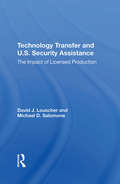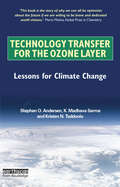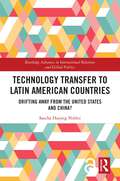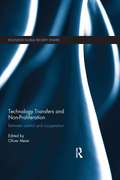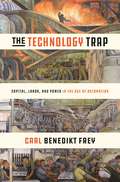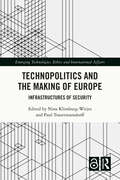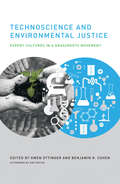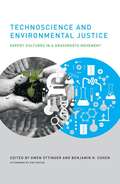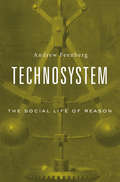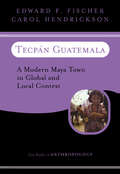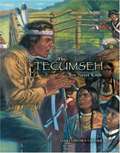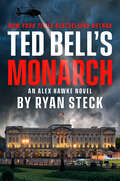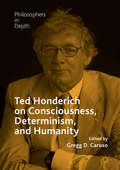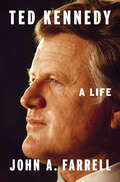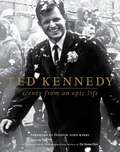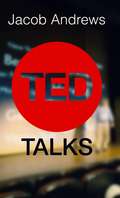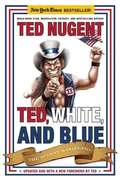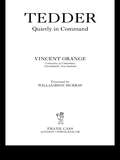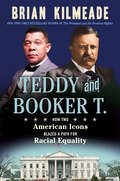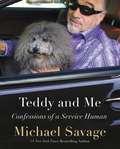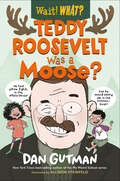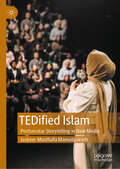- Table View
- List View
Technology Transfer And U.S. Security Assistance: The Impact Of Licensed Production
by David J Louscher Michael D SalomoneThe national security issues surrounding U.S. arms sales policies and practices have been the subjects or our research tor the past ten years. In this study the authors’ were determined to conduct a more focussed analysis of emerging policy issues tor security assistance; namely, the relationship between technology transfer and security assistance policies of the U.S. Government. This book assesses the development or indigenous arms production capabilities or recipients or U.S. security assistance. In particular we examine a seldom analyzed level of technology transfer: the transfer or less than state-of-the-art technologies and production capabilities to allies through routine security assistance decisions.
Technology Transfer for the Ozone Layer: Lessons for Climate Change
by Stephen O. Andersen K. Madhava Sarma Kristen N. Taddonio'Imagine the pride of earning the Nobel Prize for warning that CFCs were destroying the ozone layer. Then imagine that citizens, policymakers, and business executives heeded the warning and transformed markets to protect the earth. This book is the story of why we can all be optimistic about the future if we are willing to be brave and dedicated world citizens.' MARIO MOLINA, Nobel Laureate in Chemistry and Professor, University of California This book tells how the Montreal Protocol, the most successful global environmental agreement so far, stimulated the development and worldwide transfer of technologies to protect the ozone layer.Technology transfer is the crux of the 230 international environmental treaties and is essential to fighting climate change. While debate rages about obstacles to technology transfer, until now there has been no comprehensive assessment of what actually works to remove the obstacles. The authors, leaders in the field, assess over 1000 technology transfer projects funded under the Montreal Protocol‘s Multilateral Fund and the Global Environment Facility, and identify lessons that can be applied to technology transfer for climate change.
Technology Transfer to Latin American Countries: Drifting Away from the United States and China? (Routledge Advances in International Relations and Global Politics)
by Sascha Hannig NúñezHannig Núñez analyzes the processes behind technology transfers at a state-decision-making level in Latin America. She challenges the conventional notion that the United States and China hold a dominant technological presence over the region, highlighting the increasing influence from both middle powers and regional actors.This book builds on existing theory and case studies to assess the relevance of economic incentives, geopolitical rivalries, and value-driven considerations in the outcomes of technology transfer in different scenarios. It further explores the notion of a new "Cold War" between China and the United States and examines how these superpowers leverage technology transfers to extend their influence but ultimately fall short due to growing competition from previously overlooked players. In closely examining these dynamics, Hannig Núñez demonstrates how technology transfer is not solely an economic process but a significant geopolitical tool that influences international order, national sovereignty, and regional integration.An invaluable resource for students, academics, and researchers interested in the intersection between technology, cybersecurity, and international politics.Chapter 9 of this book is freely available as a downloadable Open Access PDF at http://www.taylorfrancis.com under a Creative Commons Attribution-Non Commercial-No Derivatives (CC-BY-NC-ND) 4.0 license
Technology Transfers and Non-Proliferation: Between control and cooperation (Routledge Global Security Studies)
by Oliver MeierThis edited volume examines the issue of the proliferation of dual-use technology and the efforts of the international community to control these technologies. Efforts to stop the spread of weapons of mass destruction (WMD) increasingly focus on preventing the proliferation and misuse of dual-use technologies: information, materials and equipment that can be easily applied for peaceful and hostile purposes. The threat of terrorist attacks with nuclear, biological or chemical weapons, in particular, makes it necessary to develop a sustainable non-proliferation policy that effectively hinders the misuse of dual-use technologies. In this book, leading non-proliferation experts from different regions of the world reflect on the political, legal and technical obstacles with an aim to finding a better balance between control and cooperation in dual-use technology transfer regulations. This broad approach makes it possible to compare regimes which may be structurally different but are similar in the way they attempt to regulate dual-use technology transfers by balancing controls and cooperative approaches. This book will be of much interest to students of weapons proliferation, arms control, global governance, international organizations and international security.
The Technology Trap: Capital, Labor, and Power in the Age of Automation
by Carl Benedikt FreyHow the history of technological revolutions can help us better understand economic and political polarization in the age of automation From the Industrial Revolution to the age of artificial intelligence, The Technology Trap takes a sweeping look at the history of technological progress and how it has radically shifted the distribution of economic and political power among society’s members. As Carl Benedikt Frey shows, the Industrial Revolution created unprecedented wealth and prosperity over the long run, but the immediate consequences of mechanization were devastating for large swaths of the population. Middle-income jobs withered, wages stagnated, the labor share of income fell, profits surged, and economic inequality skyrocketed. These trends, Frey documents, broadly mirror those in our current age of automation, which began with the Computer Revolution.Just as the Industrial Revolution eventually brought about extraordinary benefits for society, artificial intelligence systems have the potential to do the same. But Frey argues that this depends on how the short term is managed. In the nineteenth century, workers violently expressed their concerns over machines taking their jobs. The Luddite uprisings joined a long wave of machinery riots that swept across Europe and China. Today’s despairing middle class has not resorted to physical force, but their frustration has led to rising populism and the increasing fragmentation of society. As middle-class jobs continue to come under pressure, there’s no assurance that positive attitudes to technology will persist.The Industrial Revolution was a defining moment in history, but few grasped its enormous consequences at the time. The Technology Trap demonstrates that in the midst of another technological revolution, the lessons of the past can help us to more effectively face the present.
A Technomoral Politics: Good Governance, Transparency, and Corruption in India
by Aradhana SharmaExamining anticorruption battles and transparency laws to ask: what makes for good governance, and can it limit liberal democratic politics as much as encourage it? Good governance is meant to empower citizens, increase democratic participation, and make states transparent and accountable, yet this liberal democratic imperative can also promote populist authoritarian rule. Bringing together discourses on ethical goodness with the technicalities of governance as expressed in laws and policies, Aradhana Sharma develops the concept of &“technomoral politics&” to navigate this fraught topic. With a focus on the work of activists, citizens, and state officials, she offers an ethnographic account of the contradictions and dangers of good-governance politics in twenty-first-century India. A Technomoral Politics follows the evolution of a group of activists in New Delhi led by Arvind Kejriwal from 2008 to 2014 as they morphed from a protransparency NGO to a mass movement against state corruption to a populist party that promised to change the political system through laws and policies. Sharma explores the technomoral framing of state opacity and corruption as well as the limits of the law in resolving these issues, probing such themes as the contradictory relationship between transparency and bureaucracy and the classed and gendered nature of democratic state institutions. By examining scalar dimensions of good-governance politics, from the hyperlocal work of activists to global trends, A Technomoral Politics illuminates the paradoxes, limits, and risks of a system that is meant to spread liberal democratic principles but that also ends up promoting antidemocratic, populist-authoritarian forms of rule. Retail e-book files for this title are screen-reader friendly.
Technopolitics and the Making of Europe: Infrastructures of Security (Emerging Technologies, Ethics and International Affairs)
by Paul TrauttmansdorffThis book explores the processes and practices of the securitization and de-securitization of European infrastructures and how political institutions interact with security and insecurity. Expert contributors address distinct areas, from border politics and biosecurity to health governance and law and border control enforcement, to examine the various ways in which infrastructures are envisioned, designed, negotiated and built. They explore how ‘infrastructuring’ contributes to emergent forms of European identity, integration, and statehood. The book will appeal to scholars and students of Science and Technology Studies, Political Sociology, Critical Security Studies, International Relations, European Integration Studies, Infrastructure Studies, or Critical Border and Migration Studies. The Introduction and the Afterword of this book are freely available as a downloadable Open Access PDF at http://www.taylorfrancis.com under a Creative Commons Attribution-Non Commercial-No Derivatives (CC-BY-NC-ND) 4.0 license.
Technoscience and Environmental Justice: Expert Cultures in a Grassroots Movement (Urban and Industrial Environments)
by Kim FortunCase studies exploring how experts' encounters with environmental justice are changing technical and scientific practice.Over the course of nearly thirty years, the environmental justice movement has changed the politics of environmental activism and influenced environmental policy. In the process, it has turned the attention of environmental activists and regulatory agencies to issues of pollution, toxics, and human health as they affect ordinary people, especially people of color. This book argues that the environmental justice movement has also begun to transform science and engineering. The chapters present case studies of technical experts' encounters with environmental justice activists and issues, exploring the transformative potential of these interactions. Technoscience and Environmental Justice first examines the scientific practices and identities of technical experts who work with environmental justice organizations, whether by becoming activists themselves or by sharing scientific information with communities. It then explore scientists' and engineers' activities in such mainstream scientific institutions as regulatory agencies and universities, where environmental justice concerns have been (partially) institutionalized as a response to environmental justice activism. All of the chapters grapple with the difficulty of transformation that experts face, but the studies also show how environmental justice activism has created opportunities for changing technical practices and, in a few cases, has even accomplished significant transformations.
Technoscience and Environmental Justice
by Gwen Ottinger Benjamin CohenOver the course of nearly thirty years, the environmental justice movement has changed the politics of environmental activism and influenced environmental policy. In the process, it has turned the attention of environmental activists and regulatory agencies to issues of pollution, toxics, and human health as they affect ordinary people, especially people of color. This book argues that the environmental justice movement has also begun to transform science and engineering. The chapters present case studies of technical experts' encounters with environmental justice activists and issues, exploring the transformative potential of these interactions. Technoscience and Environmental Justice first examines the scientific practices and identities of technical experts who work with environmental justice organizations, whether by becoming activists themselves or by sharing scientific information with communities. It then explore scientists' and engineers' activities in such mainstream scientific institutions as regulatory agencies and universities, where environmental justice concerns have been (partially) institutionalized as a response to environmental justice activism. All of the chapters grapple with the difficulty of transformation that experts face, but the studies also show how environmental justice activism has created opportunities for changing technical practices and, in a few cases, has even accomplished significant transformations.
Technosystem: The Social Life of Reason
by Andrew FeenbergWe live in a world of technical systems designed in accordance with technical disciplines and operated by technically trained personnel—a unique social organization that largely determines our way of life. Andrew Feenberg’s theory of social rationality represents both the threats of technocratic modernity and the potential for democratic change.
Técnicas de coaching de Vladimir Putin
by Robert Sears¿Qué puede hacer Vadimir Putin por tu vida personal? Una guía para convertirte en el dictador que siempre has querido ser, inspirada en nuestro autócrata preferido. ¿Quieres saber cómo llevar tu relación de pareja? ¿Cómo educar a tus hijos? ¿Cómo interferir en el AMPA? ¿Cómo anexionar los espacios comunes de tu lugar de trabajo a tu imperio personal? ¿O quizás cómo derrocar a tus enemigos revelando información comprometida sobre esa vez que no se lavaron las manos al salir del baño? Estos y otros muchos interrogantes fundamentales encuentran su respuesta en décadas de una efectiva práctica de eliminación de contrincantes y de manipulación estratégica de procesos electorales. Lleno de anécdotas, ideas e ilustraciones para emular a Vladimir Putin a pequeña escala, el nuevo libro de Rob Sears es la guía perfecta para liberar al autócrata que todos llevamos dentro.
Tecpan Guatemala: A Modern Maya Town In Global And Local Context (Case Studies in Anthropology)
by Edward F Fischer Carol HendricksonWhat does it mean to be Maya in the modern world? Focusing on a Guatemalan town, this case study explores the cultural, political, and economic changes of this society over time. . This case study of a highland Guatemala town examines what it means to be Maya in a rapidly changing and globalized world. In providing an historical synopsis of the Kaqchikel Maya from preColumbian through Colonial times to the present day, this volume focuses on the use of language, dress, and crafts as emblems of ethnicity, nationality, and political allegiance. Tecpn considers the dynamics of ethnic boundaries in light of the use of the Kaqchikel language versus Spanish, the growing role of Protestantism and the revitalization of traditional Maya religion versus Catholicism, and traditional subsistence agriculture in the face of an expanding reliance on export crops. It examines in particular the role of weaving and other indigenous crafts in linking Tecpanecos to larger economic and political orbits and for defining local, regional, and national identities. As a result, this accessibly written book demonstrates that even traditional Maya cultural forms are actively constructed in the context of intense global connections.
The Tecumseh You Never Knew
by James Lincoln CollierTecumseh was fearless in battle. And like many, he was determined to save his land and his people from the American settlers. But Tecumseh, more than any of the others, worked out a realistic plan for keeping the settlers out of Indian lands, and he came closer to doing it than any other.
Ted Bell's Monarch (An Alex Hawke Novel)
by Ryan SteckTed Bell's New York Times bestselling series returns with Lord Alexander Hawke facing his greatest challenge yet—to find the missing king of Britain.Following a successful but costly mission to destroy an enemy outpost in Antarctica, Alex Hawke is looking forward to some quiet time at Teakettle Cottage, his home in Bermuda, along with his family. But he's not a man who can avoid trouble.Former Chief Inspector of Scottland Yard Ambrose Congreve calls him with stunning news. Just days away from a controversial vote threatening to tear the United Kingdom apart at the seams, King Charles has disappeared while vacationing at Balmoral Castle. The prime minister believes she can keep the news quiet for no more than 72 hours. After that, Britain will be plunged into chaos.With the fate of the kingdom hanging in the balance, it's up to Lord Hawke to find and rescue the missing monarch before it's too late.
Ted Honderich on Consciousness, Determinism, and Humanity (Philosophers in Depth)
by Gregg D. CarusoThis collection of original essays brings together a world-class lineup of philosophers to provide the most comprehensive critical treatment of Ted Honderich’s philosophy, focusing on three major areas of his work: (1) his theory of consciousness; (2) his extensive and ground-breaking work on determinism and freedom; and (3) his views on right and wrong, including his Principle of Humanity and his judgments on terrorism. Grote Professor Emeritus of the Philosophy of Mind and Logic at University College London, Honderich is a leading contemporary philosopher of mind, determinism and freedom, and morals. The collection begins with a comprehensive introduction written by Honderich followed by fourteen original chapters separated into three sections. Each section concludes with a set of remarks by Honderich. Contributors include Noam Chomsky, Paul Snowdon, Alastair Hannay, Barbara Gail Montero, Barry Smith, Derk Pereboom, Paul Russell, Kevin Timpe, Gregg D. Caruso, Mary Warnock, Paul Gilbert, Richard J. Norman, Michael Neumann, and Saul Smilansky.
Ted Kennedy: A Life
by John A. FarrellLONGLISTED FOR THE 2022 NATIONAL BOOK AWARD FOR NONFICTIONAn enthralling and ground-breaking new biography of one of modern America&’s most fascinating and consequential political figures, drawing on important new sources, by an award-winning biographer who covered Kennedy closely for many yearsJohn A. Farrell&’s magnificent biography of Edward M. Kennedy is the first single-volume life of the great figure since his death. Farrell&’s long acquaintance with the Kennedy universe and the acclaim accorded his previous books—including his New York Times bestselling biography of Richard Nixon, a finalist for the Pulitzer Prize—helped garner him access to a remarkable range of new sources, including segments of Kennedy&’s personal diary and his private confessions to members of his family in the days that followed the accident on Chappaquiddick. Farrell is, without question, one of America&’s greatest political biographers and a storyteller of deep wisdom and empathy. His book does full justice to this famously epic and turbulent life of almost unimaginable tragedy and triumph.As the fourth son of the close-knit but fiercely competitive Kennedy clan, Ted was the runt of the litter. Expelled from Harvard University for cheating, he was a fun-loving playboy who nevertheless served his brothers loyally and effectively. It was easy to take Ted lightly, and many did. But when he was elected to the United States Senate at the age of thirty to fill his brother Jack&’s seat, something unexpected happened: he found his home and his calling there. Over time, Ted Kennedy would build arguably the most significant senatorial career in American history.His life was buffeted by heartbreak: the violent deaths of his three older brothers, his own terrible plane crash, his children&’s bouts with cancer, and the hideous self-inflicted wounds of Chappaquiddick and stretches of drinking and womanizing that caused irreparable damage to an already fragile first marriage. Those wounds scarred Ted deeply but also tempered his character, and, eventually, he embarked on a run as legislator, party elder, and paterfamilias of the Kennedy family that would change America for the better. John A. Farrell brings us the man as he was, in strength and weakness, his profound but complicated inheritance and his vital legacy, as only a great biographer can do. Without the story this book tells, no understanding of modern America can be complete.
Ted Kennedy
by Boston GlobeThe extraordinary life of senator Edward Moore Kennedy captures two vivid stories: one is of an iconic senator who experienced the greatest of triumphs and the most devastating of losses, and the other is a chronicle of the most dramatic moments in our recent American history, including the assassination of a president and the struggle for civil rights. Through more than two hundred stunning black-and-white photographs pulled from the pages of The Boston Globe and its extensive archives, Ted Kennedy: Scenes from an Epic Life provides a gorgeous visual account of Ted's incredible journey from his joyous birth to the tragic announcement of his battle with brain cancer, including highlights from his childhood in New York, Hyannis Port, and London; his days at Harvard and in the Senate; and his roles as devoted brother, husband, father, uncle, and grandfather. In this unique collection, archival materials and fresh interviews combine to create a richly detailed portrait of the man known to many as Uncle Ted. Vibrant photographs, most never before published in book form (and many unseen for decades), as well as essays and quotations illustrate the man and the statesman from a perspective that is both intimate and objective. It is a collection in which Ted's closest and keenest observers provide the context necessary to appreciate his place in this most famous of American families. Here you will find, among the many unforgettable photographs featured in these pages, contributions by such illustrious names as Stan Grossfeld, Ulrike Welsch, Ollie Noonan Jr., Paul J. Connell, and Ted Dully. Featured essays include the reflections of the Globe's former Washington bureau chief, Martin F. Nolan, and longtime photojournalist Bill Brett. Their images and words bear eyewitness testimony that will resonate with anyone who lived through the Camelot years or simply seeks to understand the Kennedy mystique. Ted Kennedy: Scenes from an Epic Life has no equal because Ted Kennedy's long, complicated relationship with the press has no equal. It is the rarest kind of pictorial history: it is history in the making.
TED Talks
by Jacob Andrews Francesco PireddaAgisci da professionista anche se hai paura di parlare in pubblico. Tenere una presentazione TED che sia memorabile e di ispirazione è il tuo sogno? Le conferenze TED sono popolari per un motivo: catturano e ispirano gli ascoltatori, portandoli in un viaggio emozionante. E anche se non ti stessi preparando per una vera presentazione TED, potrai usare gli stessi principi per sbalordire il tuo pubblico e tenere il discorso della tua vita. Con questo libro imparerai esattamente che cosa stimola e mantiene alto l’interesse del pubblico, mentre modellerai le migliori presentazioni del mondo! Ecco alcune cose che imparerai con questo libro: - Gli elementi esatti che compongono una grande conferenza TED - Come scegliere l’argomento scoprendo la tua grande idea - Come pianificare e strutturare il tuo discorso - Come conquistare il pubblico - Quali tasti premere per ottenere una vera risposta emotiva dallo spettatore - Come creare una relazione con il pubblico - Come dare la propria interpretazione su qualsiasi argomento - L’esatta struttura da seguire nel discorso - Le 4 cose che devi assolutamente includere nella presentazione - I 3 metodi di esposizione … e quale sia il più adatto a te - Cosa mettere sulle slide e … come decidere se hai davvero bisogno di slide! - Come gestire l’ansia da palcoscenico, inclusi 3 consigli per calmare i nervi prima e durante la presentazione - La cosa numero uno da evitare durante il discorso (fallo, e il pubblico si sentirà seriamente insultato) E questi sono solo gli elementi principali!
Ted, White, and Blue: The Nugent Manifesto
by Ted NugentIt's About Time.America has been craving leadership-and at last a gun-slinging, mega-rock star, deerslayer, and patriot has stepped forward to provide it. Make way for Ted Nugent. Cocked, locked, and ready to rock, the Motor City Madman, the thinking man's Abraham Lincoln, has unleashed the ultimate high-octane political manifesto for the ages in Ted, White, and Blue-the most important patriotic statement since the Constitution. In Ted, White, and Blue you'll discover:Why war is the answer to so many of our current problemsWhy if Ted were a Mexican, he'd start a revolution (and how, since he's not, we can control our own borders)How to put Uncle Sam on a diet (a waste-watchers program for government)If you care about America, if you want to preserve, protect, and defend the land of the free and the home of the brave, if you're fed up with lazy, whining, fear mongering, government-gorging Obamaniacs, then you need to read Ted, White, and Blue: The Nugent Manifesto.
Ted, White and Blue: The Nugent Manifesto
by Ted NugentAnother hell-raising book by the famous rocker, where he comments on the state of USA and how to fix many of our problems
Tedder: Quietly in Command (Studies in Air Power #8)
by Vincent OrangeArthur Tedder became one of the most eminent figures of the Second World War: first as head of Anglo-American air forces in the Middle East, the Mediterranean and North Africa; then as Deputy Supreme Commander to General Eisenhower for the Allied campaign that began in Normandy and ended in Berlin. During those anxious, exhilarating years, he was, as The Times of London wrote, 'the most unstuffy of great commanders, who could be found sitting cross-legged, jacketless, pipe smoldering, answering questions on a desert airstrip.'After the war, promoted to five-star rank and elevated to the peerage as Lord Tedder, he was made Chief of the Air Staff, holding this appointment for longer than anyone since his time: four critical years (from 1946 to 1949) that saw the tragic start of the Cold War and the inspiring achievement of the Berlin Airlift. In 1950, he became Britain's NATO representative in Washington: a year that saw the start of a hot war in Korea that threatened to spread around the globe.This book provides the first comprehensive account of a great commander's public career and uses hundreds of family letters to portray a private life, both joyful and tragic.
Teddy and Booker T.: How Two American Icons Blazed a Path for Racial Equality
by Brian KilmeadeThe New York Times bestselling author of George Washington's Secret Six and Thomas Jefferson and the Tripoli Pirates turns to two other heroes of the nation: Theodore Roosevelt and Booker T. Washington. <p><p> When President Theodore Roosevelt welcomed the country’s most visible Black man, Booker T. Washington, into his circle of counselors in 1901, the two confronted a shocking and violent wave of racist outrage. In the previous decade, Jim Crow laws had legalized discrimination in the South, eroding social and economic gains for former slaves. Lynching was on the rise, and Black Americans faced new barriers to voting. Slavery had been abolished, but if newly freed citizens were condemned to lives as share croppers, how much improvement would their lives really see? In Teddy and Booker T., Brian Kilmeade tells the story of how two wildly different Americans faced the challenge of keeping America moving toward the promise of the Emancipation Proclamation. <p><p> Theodore Roosevelt was white, born into incredible wealth and privilege in New York City. Booker T. Washington was Black, born on a plantation without even a last name. But both men embodied the rugged, pioneering spirit of America. Kilmeade takes us to San Juan Hill, where Roosevelt led his Rough Riders to a thrilling victory that set the stage for a legendary presidency, and to a small town in Alabama, where Washington founded the first university for African Americans, paving the way for the Civil Rights Movement. Both men abhorred the decadence and moral rot the nation had fallen into, believed that improvement through careful collaboration was possible, and trusted that the American ideals of individual liberty and hard work could propel the neediest toward success, if only those holding them back would step aside. <p><p> As he did in George Washington's Secret Six, Kilmeade has transformed this nearly forgotten slice of history into a dramatic story that will keep you turning the pages to find out how these two heroes, through their principles and courage, not only changed each other, but helped lay the groundwork for true equality. <p> <b>New York Times Bestseller</b>
Teddy and Me: Confessions of a Service Human
by Michael SavageNew York Times bestselling author Michael Savage delivers a heartwarming book about his experiences and relationship with his dog Teddy.Listeners know Teddy as the silent "other host" of The Savage Nation. He's at Michael Savage's side during every broadcast, guarding the radio equipment and nipping the engineer's sneakers. But the fun doesn't end when the "On-Air" light goes off. Teddy is Savage's constant companion, in the car, at home, and even shopping. Most important, he's Savage's inspiration, helping him remember the most important things in life are the little things. TEDDY AND ME is a rare glimpse into the life of one of America's most popular talk radio hosts. Come along for the ride as Savage and his best friend explore the streets of San Francisco, ride the "Tedevator," and read bedtime stories together. If you've ever wondered how the conservative icon who can go from zero to enraged in a matter of seconds has kept his sanity in an insane world, this book has the answer. To the political establishment, he's a force of nature, but to Teddy, Michael Savage is just his "service human." Spend a day in the life of a media giant and the most politically savvy canine alive in TEDDY AND ME.
Teddy Roosevelt Was a Moose? (Wait! What? #0)
by Dan GutmanFrom the best-selling author of My Weird School: a new entry in the offbeat and engaging biography series that casts fresh light on high-interest historic figures. Did you know that Theodore Roosevelt was shot before a rally, and went on to give his speech with the bullet in his chest? Or that he skinny-dipped in the Potomac River? Bet you didn’t know that he had a zebra, a lion, and a one-legged rooster at the White House! Siblings Paige and Turner have collected some of the most unusual and surprising facts about the larger-than-life president, from his childhood and his Rough Rider days to his rise to politics and his complicated presidential legacy. Narrated by the two spirited siblings and animated by Allison Steinfeld’s upbeat illustrations, Teddy Roosevelt is an authoritative, accessible, and one-of-a-kind biography infused with Dan Gutman’s signature zany sense of humor.
TEDified Islam: Postsecular Storytelling in New Media
by Jasbeer Musthafa MamalipurathThis book represents one of the initial comprehensive studies of TED Talks on Islam. It situates TED Talks on Islam as postsecular (secular’s renewed interest in faith) discourse and asks how TED represents and narrates Islam. It also examines the perspectives of both Muslim and non-Muslim TED viewers about TED’s storytelling strategies as well as on the platform. Finally, the book studies the features of the authority that both Muslim and non-Muslim TED speakers embody as ‘spokespersons of Islam’. By doing so, this book offers an empirical and context-oriented understanding of postsecular storytelling by problematising the secular translations of Islam.
